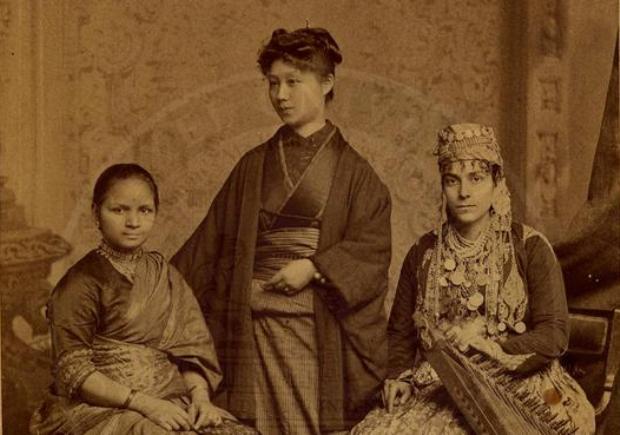Historical Photos Depict Women Medical Pioneers
The first female doctors from India, Japan and Syria, as students at the Women’s Medical College of Pennsylvania in 1885. (Photo: Legacy Center Archives, Drexel University College of Medicine)
There’s a remarkable picture that’s been making the rounds on the web recently, and it caught our eye. You may have seen the shot: it’s of a group of medical students and they’re all women.
One’s from Japan, one’s from India, and the third from Syria. They’re all wearing traditional clothes from their home countries.
Nothing too remarkable in that, you might say. Until you see the date.
1885.
These women were students at the Women’s Medical College of Pennsylvania (WMCP).
I was able to authenticate the image which resides in the archives of Drexel University which absorbed the successor to the WMCP in 2003. And, thanks to archivist Matt Herbison I was able to dig up much more.
These women were nothing short of medical pioneers. All three graduated and each of them thus became the first woman from their respective countries to get a degree in western medicine.
The most information available relates to the very determined looking woman from India, Anandibai Joshi or Joshee as was used in the archaic spelling of the 1800s.
She was a high-caste Brahmin woman who was married off at 9 to a man 20 years her senior. He was a very progressive man for his age and in an almost fatherly way encouraged his wife’s education.
But what made Joshi determined to become a doctor was the death of her 10-day old baby, when Joshi herself was just 14. Medical care for women – even high-caste women like Joshi – was simply unavailable. So she overcame incredible obstacles of caste and tradition, and a lack of money and connections, to travel to America and apply for admission to WMCP.
Here’s an extract from her letter of application to WMCP:
“[The] determination which has brought me to your country against the combined opposition of my friends and caste ought to go a long way towards helping me to carry out the purpose for which I came, i.e. is to to render to my poor suffering country women the true medical aid they so sadly stand in need of and which they would rather die than accept at the hands of a male physician. The voice of humanity is with me and I must not fail. My soul is moved to help the many who cannot help themselves.”
Joshi is believed to be the first Hindu woman to set foot on American soil.
Why America? Well, it’s a tribute to the Quakers of Pennsylvania, who believed in women’s rights enough to set up the WMCP way back in 1850 in Germantown.
It was first women’s medical college in the world, and immediately began attracting foreign students unable to study medicine in their home countries. First they came from elsewhere in North America and Europe, and then from further afield.
These women like Anandibai Joshi in India and Keiko Okami in Japan heard about WMCP, and made the decision to defy expectations of society and family and travel independently to America to apply, then figure out how to pay for their tuition and board.
It’s a reminder just how exceptional America was in the 19th century. We often spend so much time remembering all the legitimately bad things in US history. But compared to the rest of the world, America was this inspirational beacon of freedom and equality.
The cost of a medical degree for these women was $325.50, which was a lot of money back in 1885.
Keiko Okami returned to Tokyo and was recognized as a doctor and appointed head of gynecology at one of the main hospitals. But she resigned a few years later when the Emperor refused to receive her during a visit to the hospital, because she was a woman.
Then she went into private practice. She was visited by a representative from the College in 1939, just before WWII. She died two years later at the age of 81.
Sabat Islambouli is also believed to have gone back to Damascus, and then was in Cairo, Egypt, in 1919 according to the alumnae list of that year. But after that the college lost touch with her and it’s not known what happened to her ultimately.
When Anandibai Joshi graduated, the WMCP received a letter of congratulations from Britain’s Queen Victoria, who was also Empress of India.
Joshi was appointed to a position as physician-in-charge of the female ward at the hospital in the princely state of Kolhapur. But tragically she contracted tuberculosis and died within the year, at age 21. She’s still remembered as something of a hero among Indian feminists.
Again breaking with tradition, Joshi’s husband sent her ashes to one of her American friends, who laid them to rest in Poughkeepsie, New York.
WCMP also helped transform America, says Woolf. Besides the international students, it also produced the nation’s first Native American woman doctor, Susan LeFlesche, while African-Americans were quite a common site in the College, some of whom were former slaves like Eliza Grier. And many American graduates went overseas as medical missionaries, especially to China, Korea, India and elsewhere.
A 1904 newspaper cutting, the College could boast alumnae hailing from Canada, Jamaica, Brazil, England, Sweden, Denmark, Switzerland, Russia, Syria, India, China, Japan, Burmah, Australia, and the Congo Free State.
Its living alumnae number about a 1,000, and are found in nearly every part of the American republic and in many foreign countries, among them Egypt, India, China, Japan, Persia and Korea.
Our coverage reaches millions each week, but only a small fraction of listeners contribute to sustain our program. We still need 224 more people to donate $100 or $10/monthly to unlock our $67,000 match. Will you help us get there today?
